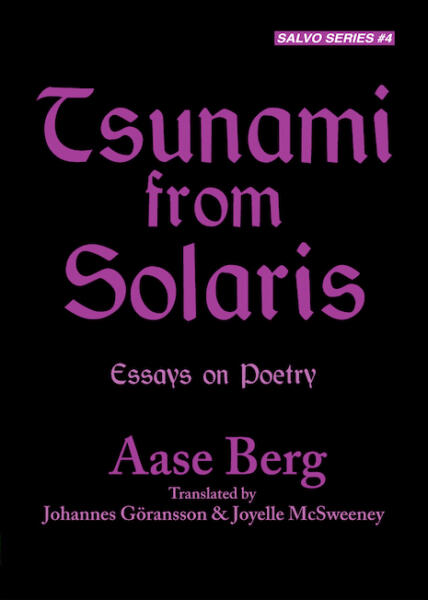Translated by Johannes Göransson and Joyelle McSweeney
[for the entire text see Tsunami from Solaris (Action Books, 2019)]
The scars wait for new attacks. They are not at all as safely and reliably passive as one might expect. In some cases, it’s not a matter of an end but rather about a new beginning for the wound’s history. In this part of the wound’s history, the scars are not so much sign of something that has already happened – for example “the catastrophe of our time” – as entrances toward new, open, pink-glowing flesh wounds. Small children often find an aggressive joy in picking away at scabs. One can go even further: like HP Lovecraft, dig down into the catacombs and the underground muck to find in the earth’s depths new, imagination-stirring lifeforms. Certain poets are constantly repeating this movement of digging into the wounds, plundering the graves. Eva Kristina Olsson is one such poet. The goal of such a backwards movement is perhaps “the excluded middle” or simply a somewhat interesting life.
…
In difference to the wound, the scar has a temporal dimension. When the wound is open and when the poem by certain poets takes shape there is no time, just forever screaming now. The words, to the extent that they have articulable meaning, can keep the inside inside and the outside outside. But the sum of the words does not make a poem – there is also an invisible putty, a spirit. The poem in and beyond the words is a gaping hole, a chasm or void: a wound. In the poetic now, experience is more important than documentation, summarizing or limitation. The poem is formless, a protoplasma, a jellyfish, an amoeba that glides around and ignores the human race’s serious chronologies. At the same time as the poem is created it tears up the now in pain, in now-existence. The poem is in many cases a becoming – as well as boiling – wound. No healing process can take place when it runs out of the pen.
…
But what comes after the scar? Mold? Fossilization, petrification? The weaving together, the strangling? The body’s death in the coffin deep won in Lovecraft’s wonderful underground soil? Yes, death, as usual. One stands at the edge of the process and grows depressed. Doesn’t it get more interesting than this?
…
One exciting example of scar-breakage can be found in Eva Kristina Olsson’s poetry: here the scar is torn up and becomes a wound again. This I how it sounds in Sångkanter (Song Edges):
the edges flee
i am not in the place
around the throat hangs a stone
the edges flee
i am in the place
the open shaking
The edges here function as scar formations, signs, structure. The stone is pulled down and “the edges flee.” Down in the hole, “i am in the place,” down in the wound, the now. The “place” no longer has any edges: the outside runs in, the inside runs out – the boundary that made “the place” into a place and the wound into a wound has left the field open to all eternity. The wound has been scratched open here (except in the micro state, in the words/scars themselves), and the boundaries are about the loosen and fall off.
But in her poetry Olsson is trying to get a handle on the edges, to the extent that the poem is still situated in relationship to them. It’s just a matter of time before one gives up hope and finally lets go of the demand for an edge, to instead give oneself totally to the wound. This is where one finds oneself truly in the site of “open shaking.” The place gives way. In Olsson’s most recent collection, The Sacrifice, the cultural and cosmic outlines have been thrown into an irreversible state of dissolution. We find ourselves in the centrifugal flesh, in a chaos of preoedipal now-existence, in the absolutely naked wound’s rabid intestinal mess. It’s obviously dangerous, like all true poetry.
…
Beyond the scar awaits mold or stone death. But perhaps it is the wound-scream that will lead us backwards in toward the excluded third way as through a black hole? Will we ever be surprised? When the fuck will something truly new take place? And if so, what will it be?
(1995)
Aase Berg is the author of ten books, including most recently Hackers and the controversial autofiction The Hag. Several of her books have been published in English translation: Remainland: Selected Poems of Aase Berg, With Deer, Dark Matter, Transfer Fat, and Hackers. She has won numerous awards for both her poetry and criticism.
Johannes Göransson is the author of eight books – including most recently POETRY AGAINST ALL and Transgressive Circulation: Esssays on Translation – and the translator of many more, including books by Aase Berg, Ann Jäderlund, Kim Yideum and Henry Parland. He edits Action Books and teaches in the MFA program at the University of Notre Dame. @JohannesGoranss
